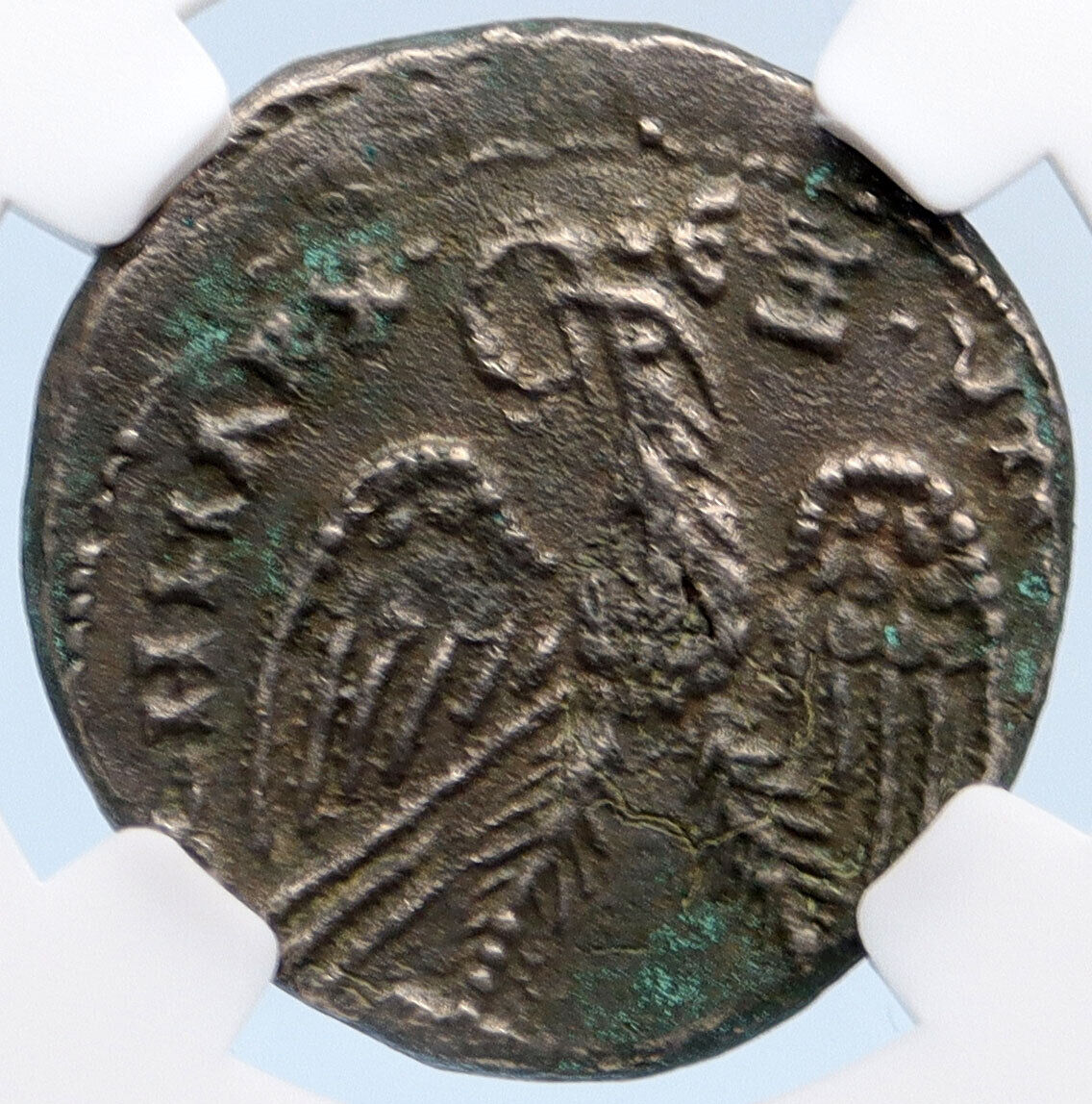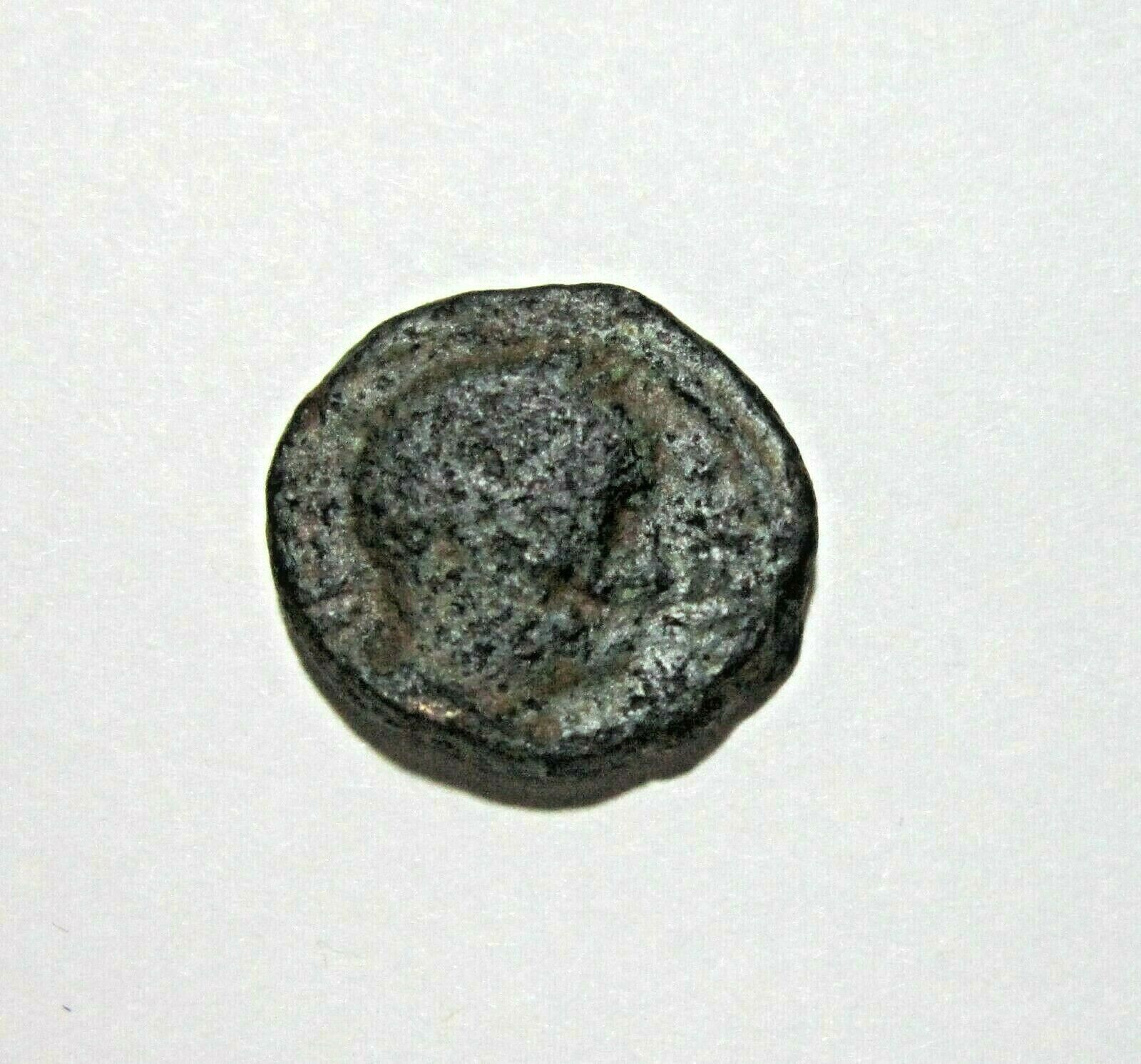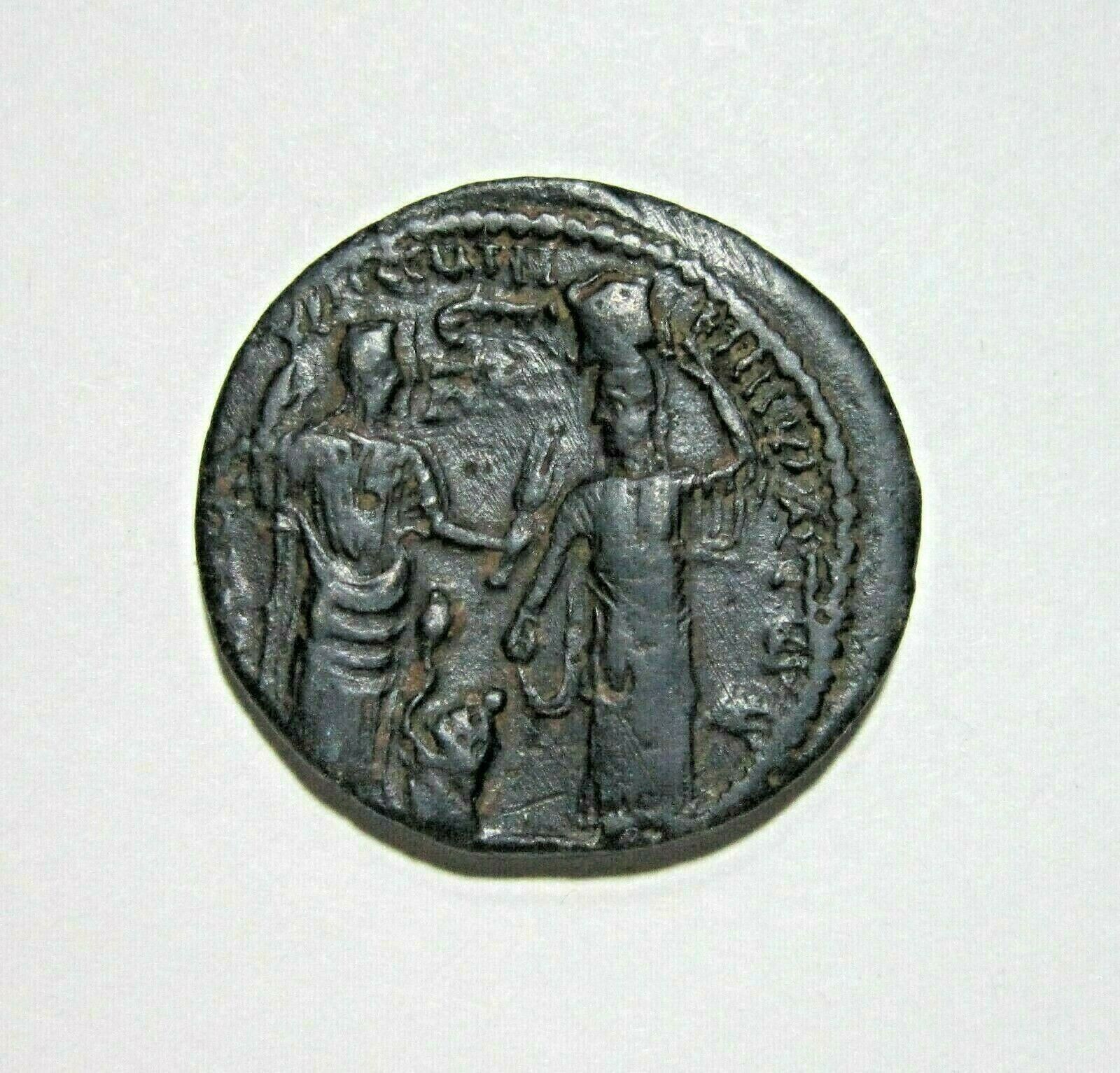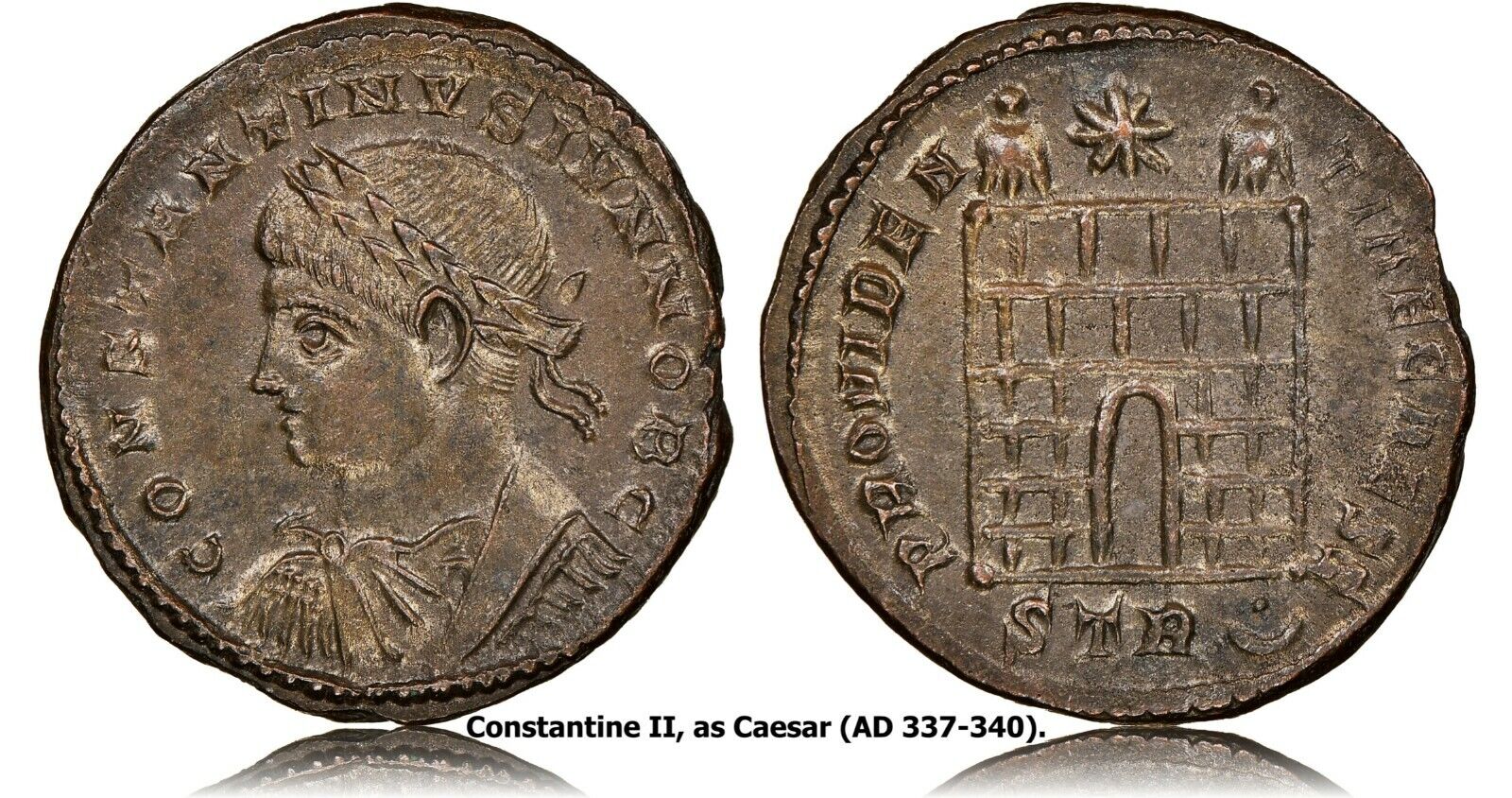-40%
MACRINUS 217AD Ancient Roman Billon TETRADRACHM of Emesa Roman Coin NGC i61965
$ 273.92
- Description
- Size Guide
Description
Item:i61965
Authentic Ancient Coin of:
Macrinus - Roman Emperor: 217-218 A.D.
Billon Silver Tetradrachm 23mm (11.88 grams) of Emesa mint
Certification:
NGC Ancients
XFÂ 4529166-004
Laureate head right.
ΔΗΜΑΡX. ЄΞ. VΠΑΤΟC, Eagle standing facing with open wings, head left, wreath in beak; nothing between legs.
You are bidding on the exact item pictured, provided with a Certificate of Authenticity and Lifetime Guarantee of Authenticity.
Billon
is an alloy of a precious metal (most commonly silver) with a majority base metal content (such as copper). It is used chiefly for making coins, medals, and token coins. The word comes from the French
bille
. The use of billon coins dates from ancient Greece through the Middle Ages. During the 6th and 5th centuries BC, some cities on Lesbos Island used coins made of 60% copper and 40% silver. Billon coins are perhaps best known from the Roman Empire, where progressive debasements of the Roman denarius and the Roman provincial tetradrachm.
Macrinus - Roman Emperor: 217-218 A.D.
| Augustus: 217-218 A.D. (217-218 A.D. - Sole Reign) (218 A.D. with Diadumenian) |
| Father of Diadumenian |
Macrinus
(Latin:
Marcus Opellius Severus Macrinus Augustus
; c. 165 - June 218) was Roman Emperor from April 217 to 8 June 218. He reigned jointly with his young son Diadumenianus. Macrinus was by origin a Berber from Mauretania Caesariensis. A member of the equestrian class, he became the first emperor who did not hail from the senatorial class and was the first emperor from Mauretania. Before becoming emperor, Macrinus served under Emperor Caracalla as a praetorian prefect and dealt with Rome's civil affairs. He later conspired against Caracalla and had him murdered in a bid to protect his own life, succeeding him as emperor.
Macrinus was proclaimed emperor of Rome by 11 April 217, while in the eastern provinces of the empire, and was subsequently confirmed as such by the Senate; however, for the duration of his reign he never had the opportunity to return to Rome. His predecessor's policies had left Rome's coffers empty and the empire at war with several kingdoms, including Parthia, Armenia and Dacia. As emperor, Macrinus first attempted to enact reform to bring economic and diplomatic stability to Rome. While Macrinus' diplomatic actions brought about peace with each of the individual kingdoms, the additional monetary costs and subsequent fiscal reforms generated unrest in the Roman military. Julia Maesa, taking advantage of the unrest, instigated a rebellion to have her fourteen-year-old grandson, Elagabalus, recognized as emperor. Macrinus was overthrown at the Battle of Antioch on 8 June 218 and Elagabalus proclaimed himself emperor with support from the rebelling Roman legions. Macrinus fled the battlefield and headed for Rome, but was captured in Chaceldon and later executed in Cappadocia. He sent his son to the care of Artabanus V of Parthia, but Diadumenianus was also captured and executed. After Macrinus' death the Senate declared him and his son enemies of Rome and had their names struck from the records and their images destroyed.
Despite his equestrian background, Macrinus was accepted by the Senate for two reasons: for the removal of Caracalla, and for having received the loyalty of the army. The senators were less concerned by Macrinus' Mauretanian ancestry than by his equestrian social background and scrutinized his actions as emperor. Their opinion of him was reduced by his decisions to appoint men to high offices who were of similarly undistinguished background. Only the Senate had the constitutional power to choose the emperor from among the senators and Macrinus, not being a senator and having become emperor through force rather than through traditional means, was looked down upon.
Macrinus had several issues that he needed to deal with at the time of his accession, which had been left behind by his predecessor. As Caracalla had a tendency towards military belligerence, rather than diplomacy, this left several conflicts for Macrinus to resolve. Second, Caracalla had been a profligate spender of Rome's income. Most of the money was spent on the army; he had greatly increased their pay from 2,000 sesterces to 3,000 sesterces per year. In turn, Caracalla had stripped bare whatever sources of income he had. This left Rome is a dire fiscal situation, which also had to be resolved by Macrinus.
Macrinus was at first occupied by the threat of the Parthians, with whom Rome had been at war since the reign of Caracalla. Macrinus settled a peace deal with the Parthians, after fighting an indecisive battle at Nisibis in 217. In return for peace, Macrinus was forced to pay a large indemnity to the Parthian ruler Artabanus V. Simultaneously, Rome was under threat from Dacia and Armenia; any deal with Parthia might have been beneficial to Rome. Next, Macrinus turned his attention to Armenia. He settled a peace treaty with them by returning the crown and loot to Tiridates and releasing his mother from prison, returning Armenia to its status as a client kingdom of Rome. Macrinus made peace with the Dacians by releasing hostages, though this was likely not handled by himself but by Marcius Agrippa. In matters of foreign policy, Macrinus showed a tendency towards settling disputes through diplomacy and a reluctance to engage in military conflict, though this may have been due to lack of resources and manpower than his own personal preference.
Macrinus began to overturn Caracalla's fiscal policies and moved closer towards those that had been set forth by Septimius Severus. One such policy change involved the Roman legions; the soldiers that were already enlisted during Caracalla's reign enjoyed exorbitant payments, it would be impossible for Macrinus to reduce enlisted soldiers' pay without them rebelling and so instead reduced the pay of new recruits to the level that had been set by Severus. Macrinus revalued the Roman currency, increasing the silver purity and weight of the denarius from 50.78 percent and 1.66 grams at the end of Caracalla's reign to 57.85 percent and 1.82 grams from Fall 217 to the end of his reign, so that it mirrored Severus' fiscal policy for the period 197-209 A.D. After 209 A.D. Macrinus' goal with these policies might have been to return Rome to the relative economic stability that had been enjoyed under Severus' reign, though it came with a cost. The fiscal changes that Macrinus enacted might have been tenable otherwise, but not for the military. By this time the strength of the military was too great and by enacting his reforms he angered the soldiers and paved the way for his downfall.
Caracalla's mother Julia Domna was initially left in peace when Macrinus became emperor. This changed when Macrinus discovered that she was conspiring against him and had her placed under house arrest in Antioch. By this time Julia Domna was suffering from an advanced stage of breast cancer and soon died in Antioch, possibly by starving herself. Afterwards, Macrinus sent Domna's sister Julia Maesa and her children back to Emesa in Syria, from where Maesa set in motion her plans to have Macrinus overthrown. Macrinus had decided to remain in Antioch instead of going to Rome upon being declared emperor, a step which furthered his unpopularity in Rome and contributed to his eventual downfall.
Julia Maesa had retired to her home town of Emesa with an immense fortune, which she had accrued over the course of twenty years. She took her children, Julia Soaemias and Julia Mamaea, and grandchildren, including Elagabalus, with her to Emesa. Elagabalus, aged 14, was the chief priest of the Phoenician sun-deity Elagabalus (or El-Gabal) in Emesa. Soldiers from Legio III
Gallica
(Gallic Third Legion), that had been stationed at the nearby camp of Raphanea, often visited Emesa and went to see Elagabalus perform his priestly rituals and duties while there. Julia Maesa took advantage of this, to suggest to the soldiers that Elagabalus was indeed the illegitimate son of Caracalla. On May 16, Elagabalus was proclaimed emperor by the Legio III
Gallica
at its camp at Raphanea. Upon Elagabalus' revolt, Macrinus travelled to Apamea and conferred the title of Augustus onto Diadumenianus and made him co-emperor.
Macrinus realised that his life was in danger but could not decide upon a course of action and remained at Antioch. Not to remain idle, Macrinus sent Ulpinus Julianus with a force of cavalry to regain control of the rebels. This attempt to bring about an end to the rebellion failed and resulted in the death of Ulpinus and further strengthened Elagabalus' army. Soon after, a force under Elagabalus' tutor Gannys marched on Antioch and engaged a force under Macrinus on 8 June 218 near the village of Immae, located approximately 24 miles from Antioch. At some point during the ensuring Battle of Antioch, Macrinus deserted the field and fled to Antioch. Macrinus was then forced to flee from Antioch as fighting erupted in the city as well. Elegabalus himself entered Antioch as the new ruler of the Roman Empire. Macrinus fled for Rome, he managed to get to Chalcedon before being recognized and captured. His son and co-emperor Diadumenianus, sent to the care of Artbanus V of Parthia, was himself captured in transit at Zeugma and killed in June of 218. Diadumenianus' reign lasted a total of 14 months, and he died at around the age of 10. Macrinus, upon learning of his son's death, tried to escape captivity, injuring himself in the process. Unable to complete the journey, Macrinus was executed in Cappadocia and his head was sent to Elegabalus. Much like Macrinus, Diadumenianus' head was also cut off and sent to Elegabalus as a trophy.
Macrinus and his son Diadumenianus were declared
hostes
, enemies of the state, by the Senate immediately after news had arrived of their deaths and as part of an official declaration of support for the usurper Elagabalus, who was recognized in the Senate as the new Emperor. The declaration of
hostes
led to two actions being taken against the images of the former Emperors. First, their portraits were destroyed and their names were stricken from inscriptions and papyrii. The second action, taken by the Roman soldiers who had rebelled against Macrinus in favour of Elagabalus, was to destroy all of the works and possessions of Macrinus. The
damnatio memoriae
against Macrinus is among the earliest of such sanctions enacted by the Senate. Many of the marble busts of Macrinus that exist were defaced and mutilated as a response to the
damnatio memoriae
and many of the coins depicting Macrinus and Diadumenianus were also destroyed. These actions against Macrinus are evidence of his unpopularity in Rome.
Frequently Asked Questions
Mr. Ilya Zlobin, world-renowned expert numismatist, enthusiast, author and dealer in authentic ancient Greek, ancient Roman, ancient Byzantine, world coins & more.
Who am I dealing with?
You are dealing with Ilya Zlobin, ancient coin expert, enthusiast, author and dealer with an online store having a selection of over 15,000 items with great positive feedback from verified buyers and over 10 years experience dealing with over 57,000 ancient and world coins and artifacts. Ilya Zlobin is an independent individual who has a passion for coin collecting, research and understanding the importance of the historical context and significance all coins and objects represent. Most others are only concerned with selling you, Ilya Zlobin is most interested in educating you on the subject, and providing the largest selection, most professional presentation and service for the best long-term value for collectors worldwide creating returning patrons sharing in the passion of ancient and world coin collecting for a lifetime.
How long until my order is shipped?
Orders are shipped by the next business day (after receipt of payment) most of the time.
How will I know when the order was shipped?
After your order has shipped, you will be left positive feedback, and that date could be used as a basis of estimating an arrival date. Any tracking number would be found under your 'Purchase history' tab.
USPS First Class mail takes about 3-5 business days to arrive in the U.S. International shipping times cannot be estimated as they vary from country to country.
Standard international mail to many countries
does not
include a tracking number, and can also be slow sometimes.
For a tracking number and signature confirmation, you may want to do Express Mail International Shipping, which costs more, however, is the fastest and most secure. Additionally you may be able to receive your order in as little as 3-5 business days using this method. For Express Mail International, it may be possible to place up to 10-15 items in one package (for the one shipping cost) as it is flat rate envelope, which may be the most cost-effective, secure and fastest way to receive items internationally. Send me a message about this and I can update your invoice should you want this method.
Getting your order to you, quickly and securely is a top priority and is taken seriously here.
Great care is taken in packaging and mailing every item securely and quickly.
Please be aware, I cannot take responsibility for any postal service delivery delays, especially for international packages as it may happen in rare instances.
What is a certificate of authenticity and what guarantees do you give that the item is authentic?
Each of the items sold here, is provided with a Certificate of Authenticity, and a Lifetime Guarantee of Authenticity, issued by a world-renowned numismatic and antique expert that has identified over 57,000 ancient coins and has provided them with the same guarantee. You will be very happy with what you get with the COA; a professional presentation of the coin, with all of the relevant information and a picture of the coin you saw in the listing. Additionally, the coin is inside it's own protective coin flip (holder), with a 2x2 inch description of the coin matching the individual number on the COA.
On the free-market such a presentation alone, can be considered a - value all in itself, and it comes standard with your purchases from me,
FREE.
With every purchase, you are leveraging my many years of experience to get a more complete context and understanding of the piece of history you are getting. Whether your goal is to collect or give the item as a gift, coins presented like this could be more prized and valued higher than items that were not given such care and attention to.
Buy a coin today and own a piece of history, guaranteed.
Is there a money back guarantee?
I offer a 30 day unconditional money back guarantee. I stand behind my coins and would be willing to exchange your order for either store credit towards other coins, or refund, minus shipping expenses, within 30 days from the receipt of your order. My goal is to have the returning customers for a lifetime, and I am so sure in my coins, their authenticity, numismatic value and beauty, I can offer such a guarantee.
When should I leave feedback?
Once you receive your order, please leave a positive feedback. Please don't leave any negative feedbacks, as it happens sometimes that people rush to leave feedback before letting sufficient time for their order to arrive. Also, if you sent an email, make sure to check for my reply in your messages before claiming that you didn't receive a response. The matter of fact is that any issues can be resolved, as reputation is most important to me. My goal is to provide superior products and quality of service.
How and where do I learn more about collecting ancient coins?
Visit the "Guide on How to Use My Store" for on an overview about using my store, with additional information and links to all other parts of my store which may include educational information on topics you are looking for.












